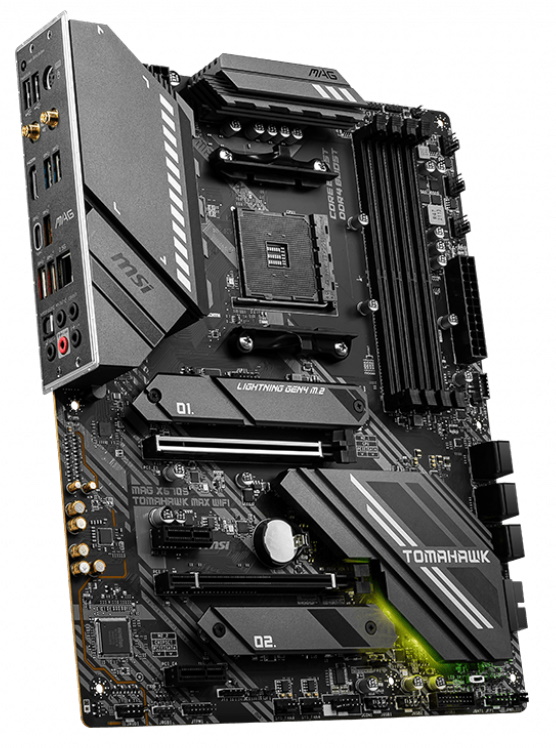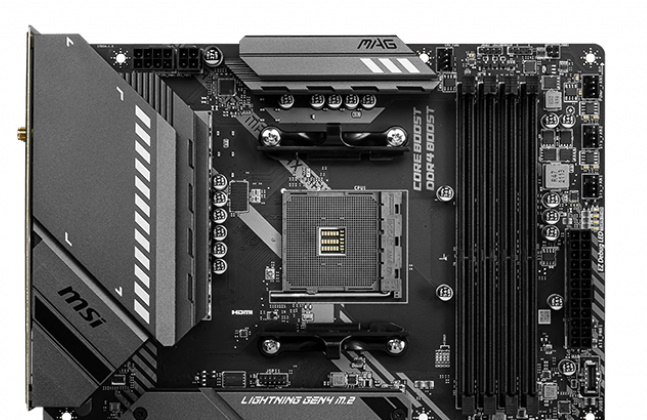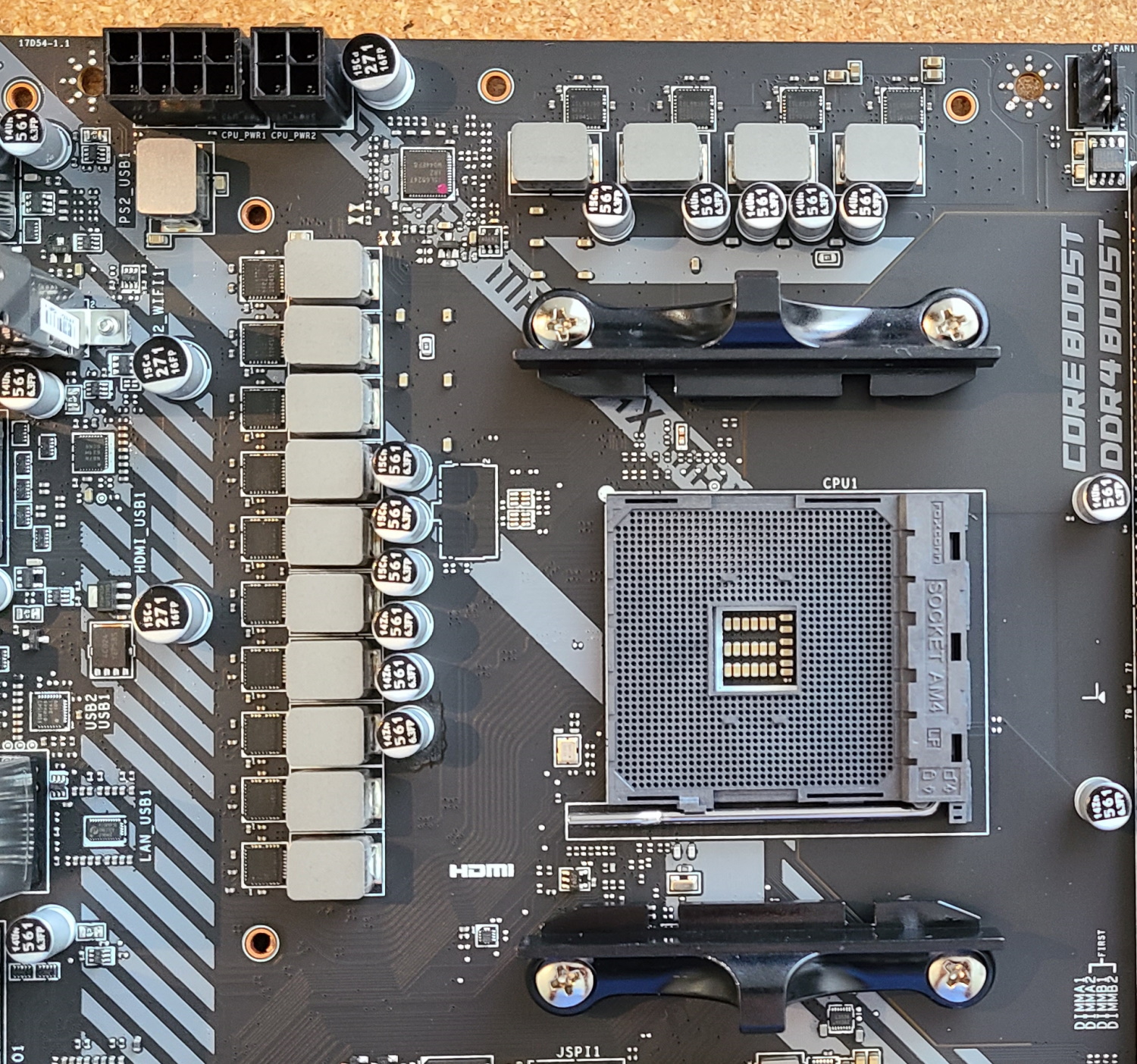Tom's Hardware Verdict
The $289.99 X570S Tomahawk MAX WIFI comes with almost everything an enthusiast needs, including ultra-fast Wi-Fi 6E and the latest Realtek audio codec, plus two PCIe 4.0 x4 M.2 slots, capable power delivery, and plenty of USB on the rearIO (though it’s missing a 20 Gbps port).
Pros
- +
+ Uses the latest audio/Wi-Fi hardware
- +
+ Capable power delivery
Cons
- -
No USB 3.2 Gen 2x2 Port
- -
Styling is still basic
Why you can trust Tom's Hardware
MSI’s MAG X570S Tomahawk MAX WIFI is, as you might guess, a refresh of the X570 Tomahawk WIFI. For $289.99, the X570S model iteratively improves on the previous board, while ditching the chipset fan, and makes a compelling option to build your budget/mid-range AMD Ryzen-based system around. It offers users the latest in audio and Wi-Fi capabilities, along with capable (though not updated) power delivery.
For a bit under $300, you get a 14-phase VRM with 60A MOSFETs capable of driving even our flagship-class AMD Ryzen 9 5950X to its ambient cooled limits. On top of that, the board has a premium Realtek 4000-series audio codec and enough USB ports for most users. It’s missing a 3.2 Gen2x2 (20 Gbps) port, but that isn’t a deal-breaker for most users. The X570S Tomahawk MAX also includes the latest in Wi-Fi, sporting a Wi-Fi 6E card and carrying over the fast 2.5 GbE from the X570 model. There are plenty of storage options as well, including two PCIe 4.0 M.2 sockets and six SATA ports. In all, the board is a well-rounded option in the budget/mid-range X570(S) space, and compares well against its peers.
On the performance side, the Tomahawk reliably chopped away at most tests, easily mixing in with the other boards we’ve tested. It didn’t lead any benchmarks and stuck close to the average throughout all testing. Its best result was in the PCMark 10 suite, which was above average almost across the board. The worst result was AIDA memory latency, where it was the slowest we’ve seen in a while. However, our other tests didn’t show this difference. Outside of that, it performed well in the 3DMark tests and Far Cry: New Dawn. Overall, the X570S Tomahawk MAX worked well with our power-hungry 5950X.
We were also able to overclock the processor to 4.4 GHz using around 1.25V without concern. Though the VRMs aren’t the most robust we’ve seen, they handled the overclocked CPU without major complaints. Memory overclocking was also easy: We dropped in the other 2x8GB DDR4 3600 sticks, enabled XMP and off we went. Read on for more details on the included features and see if the MSI X570S Tomahawk MAX WIFI lands a spot on our Best AMD motherboards list.
Specifications - MSI MAG X570S Tomahawk MAX WIFI
| Socket | AM4 |
| Chipset | X570(S) |
| Form Factor | ATX |
| Voltage Regulator | 14 Phase (12+2, 60A MOSFETs for Vcore) |
| Video Ports | (1) HDMI (v2.1) |
| USB Ports | (1) USB 3.2 Gen 2, Type- C (10 Gbps) |
| Row 6 - Cell 0 | (3) USB 3.2 Gen 2, Type-A (10 Gbps) |
| Row 7 - Cell 0 | (2) USB 3.2 Gen 1, Typ-A (5 Gbps) |
| Row 8 - Cell 0 | (2) USB 2.0 (480 Mbps) |
| Network Jacks | (1) 2.5 GbE |
| Audio Jacks | (5) Analog + SPDIF |
| Legacy Ports/Jacks | PS/2 |
| Other Ports/Jack | ✗ |
| PCIe x16 | (2) v4.0 (x16, x8/x8) |
| PCIe x8 | ✗ |
| PCIe x4 | ✗ |
| PCIe x1 | (2) v3.0 (x1) |
| CrossFire/SLI | AMD 2-Way CrossfireX |
| DIMM slots | (4) DDR4 5100(OC), 128GB Capacity |
| M.2 slots | (1) PCIe 4.0 x4 (64 Gbps) / PCIe + SATA (up to 110mm) |
| Row 20 - Cell 0 | (1) PCIe 4.0 x4 (64 Gbps) / PCIe + SATA (up to 80mm) |
| U.2 Ports | ✗ |
| SATA Ports | (6) SATA3 6 Gbps (RAID 0, 1 and 10) |
| USB Headers | (1) USB v3.2 Gen 2, Type-C (10 Gbps) |
| Row 24 - Cell 0 | (1) USB v3.2 Gen 1 (5 Gbps) |
| Row 25 - Cell 0 | (2) USB v2.0 (480 Mbps) |
| Fan/Pump Headers | (6) 4-Pin |
| RGB Headers | (2) aRGB (3-pin) |
| Row 28 - Cell 0 | (2) RGB (4-pin) |
| Legacy Interfaces | ✗ |
| Other Interfaces | FP-Audio |
| Diagnostics Panel | Post Status Checker (4 LEDs) |
| Internal Button/Switch | ✗ |
| SATA Controllers | ✗ |
| Ethernet Controller(s) | Realtek 8125B (2.5 Gbps) |
| Wi-Fi / Bluetooth | Intel AX210 Wi-Fi 6E (MU-MIMO/6GHz 160 MHz/FISMA/FIPS/BT 5.2) |
| USB Controllers | ✗ |
| HD Audio Codec | Realtek ALC4080 |
| DDL/DTS Connect | ✗ / ✗ |
| Warranty | 3 Years |
When we open up the retail box, along with the motherboard we find a basic accessory stack designed to get your PC up and running without a trip to the store. It’s not expansive, but about what we’d expect for a board in this price range. Below is a list of all included accessories.
- User Manual
- Quick Installation Guide
- (2) SATA cables
- (3) M.2 screw/standoff sets
- Installation media (USB)
- MAG sticker/Case badge
- Wi-Fi Antenna
- Support/Driver CD



Looking at the X570S Tomahawk MAX WIFI for the first time after unboxing, we see the military theme continued on top of a 6-layer matte-black PCB, and some light grey stenciling in the exposed PCIe area. All heatsinks are grey with the area over the IO sporting the MSI name in black and the chipset heatsink, sporting the Tomahawk branding. On the RGB lighting front, the Tomahawk isn’t exactly going to turn your PC into a disco. The only integrated RGB lighting is located under the chipset heatsink. This location gives the board a nice glow with the bright and saturated RGBs. If this isn’t enough, there are onboard headers to add your own.
Overall, the board looks the part of a budget/mid-range offering, but each M.2 socket has a heatsink, and the VRM heatsinks look like they can do the job (and as we’ll see in testing, they can). While this board won’t likely be the showpiece of your build, it will blend in with most themes.
Get Tom's Hardware's best news and in-depth reviews, straight to your inbox.
Focusing in on the top half of the board, starting on the left side, we spy the grey metal IO cover that doubles as an additional heatsink. On top is the MSI branding, along with white tick marks running up and down the length of the cover. The VRM heatsinks are not connected, but they both have enough mass and surface area to do the job. Wedged between the VRM heatsinks are the EPS power connectors for the CPU. The 8-pin is required and the 4-pin is optional.
Looking past the clean socket area, we run into four unreinforced DRAM slots that support up to 128GB of RAM and speeds listed up to DDR4 5100 with 1DPC 1R (DIMM Per Channel, one Rank). As always, your mileage may vary as speed compatibility depends on the processor and memory kit used.
Just above the DRAM slots is the first (of six) 4-pin fan headers. The CPU_FAN1 header here automatically detects PWM/DC fans and outputs up to 2A/24W. The PUMP_FAN1 defaults to PWM mode and outputs up to 2A/24W, which is more than adequate for most pumps. Last, SYS_FAN1-4 defaults to DC mode and supports up to 1A/12W. All headers support both modes, with adjustments made in the BIOS. There are plenty of headers and enough output to run your cooling system.
To the right of that top fan header are 3-pin ARGB and 4-pin RGB headers. In total, there are two of each, the others located on the bottom of the motherboard. If the RGBs hiding below the chipset heatsink aren’t enough, you can use these headers to add more. RGB control goes through the Dragon Center software suite and Mystic Light application.
Along the right edge of the board are three more System Fan headers, the 24-pin ATX power connector for the board and a front-panel USB 3.2 Gen1 Type-C header. Nestled between the ATX connector and fan header is the EZ Debug section. These four LEDs light up during the POST process, indicating where the boot process is, indicating where a problem is if there are issues. The four LEDs cover the CPU, DRAM, VGA and BOOT. Since the board doesn’t have the more informative 2-character debug display, this is the only tool for troubleshooting non-boot/POST issues.
Investigating the VRM layout, MSI uses a 14-phase configuration, with 12 phases dedicated to Vcore (two for SOC). Power comes from the EPS connectors and feeds the Intersil ISL69247 8-channel controller. Power then moves on to the 12 60A Intersil ISL99360 SPS MOSFETs in a mirrored configuration (no phase doublers, but two MOSFETs get one signal from the controller). In total, there’s 720A available for the CPU, which is plenty to support even our Ryzen 9 5950X while overclocked.
As shift focus down to the bottom half of the board, we find M.2 storage, PCIe slots, and the audio bits. Starting on the left side, we spy the naked Realtek ALC40480 codec and a few yellow Nichicon audio caps. Also visible is the audio separation line that’s designed to minimize EMI for the other parts of the board. I’m happy to see MSI went with a newer audio codec versus saving a few pennies on the last-generation codec. Most users will be perfectly content with the audio on the X570S Tomahawk.
In the middle of the board, we spy two M.2 slots (under the heatsinks) and four PCIe slots. Starting with the latter, there are two full-size slots, with the primary (top) slot reinforced to prevent shearing from heavy graphics cards. These two slots both support PCIe 4.0 speeds, with the top running a full x16 and the bottom running up to x4 speeds. This configuration supports AMD 2-Way CrossfireX. The two x1 slots get their bandwidth from the chipset and run up to PCIe 3.0 x1.
Looking at the M.2 storage, the X570S Tomahawk MAX WIFI sports two sockets above the primary PCIe slot and one below the secondary full-length slot. Both M.2 sockets use simple heatsinks and support SATA- and PCIe-based modules. The top socket is connected to the CPU and supports up to PCIe 4.0 x4 (64 Gbps) speeds, same as the bottom socket (though it’s connected through the chipset).
On the other side of the chipset heatsink are six SATA ports. All ports are fed from the chipset and support RAID0, 1 and 10. With all of the lanes available from the processor and chipset, there’s no lane sharing with M.2, PCIe, or SATA ports. In other words, you can run both M.2 sockets with SATA or PCIe drives and have all six SATA ports running too. Just below the SATA ports is a USB 3.2 Gen1 port for additional front-panel USB.
Across the bottom are several headers, including RGB, USB and more. There’s also a convenient switch in this area to disable the integrated RGB LEDs. Here’s the complete list, from left to right:
- Front panel audio
- 4-pin RGB header
- TPM header
- (2) Sys Fan headers
- COM header
- (2) USB 2.0 headers
- USB 3.2 Gen1 header
- 4-pin RGB header
- Front panel header
- LED power header
As we shift focus to the rear IO, we see a black pre-installed IO plate that matches the board’s theme and includes the MAG branding stenciled on, along with other labels. From left to right, we spy a legacy PS/2 port, and below that two USB 2.0 ports. To the right are the Wi-Fi 6E antenna connectors. Video output runs through the HDMI port, and just above that are two USB 3.2 Gen1 ports. There are another four USB ports to the right -- three USB 3.2 Gen2 Type-A and one 3.2 Gen2 Type-C. In all, the eight ports of varying speeds should be enough for most users. I would like to see a 3.2 Gen 2x2 port, though. Just above the red USB ports is the Realtek 2.5 GbE connector. Finally, on the far right is the 5-plug plus SPDIF audio stack.
MORE: Best Motherboards
MORE: How To Choose A Motherboard
MORE: All Motherboard Content

Joe Shields is a staff writer at Tom’s Hardware. He reviews motherboards and PC components.
-
eklipz330 does anyone x570 chipset fan EVER turn on? i have mine on the silent profile and it almost never turns on. i leave hwinfo running and even with a 3080, my chipset fan never even hits the threshold to turn on. I've heard you could even change the TIM on it and it would bring the temperatures down even lower.Reply -
Geezer760 These are your words in first paragraph: "and makes a compelling option to build your budget/mid-range AMD Ryzen-based system around." - Since when is a $290.00 MB considered "Budget" or "Mid-range", imo $290.00 is still too expensive even for mid-range. "JUST BUY IT" right?Reply -
jpe1701 ReplyGeezer760 said:These are your words in first paragraph: "and makes a compelling option to build your budget/mid-range AMD Ryzen-based system around." - Since when is a $290.00 MB considered "Budget" or "Mid-range", imo $290.00 is still too expensive even for mid-range. "JUST BUY IT" right?
Toms Hardware isn't the only ones trying to sugar coat the dramatic increase in the cost of motherboards over the last few years. -
Alvar "Miles" Udell I would say this MSI board is great, but it's priced about $30 too high where the main buyers are people who will be going long on Socket AM4 and will be wanting forward looking features like more than 2 M.2 slots.Reply
I would say the Gigabyte X570S Aero G is a better choice. Yes it's $60 which isn't chump change, it's a 20% price increase, but you get 2 more M.2 ports and a host of additional USB ports, including the USB 3.2 Gen 2x2 port lacking on this board, and really the only tradeoff is WiFi 6 vs 6E.
Gigabyte X570S Aero G Review: A Silent, Updated Vision | Tom's Hardware (tomshardware.com) -
JoBalz Replyeklipz330 said:does anyone x570 chipset fan EVER turn on? i have mine on the silent profile and it almost never turns on. i leave hwinfo running and even with a 3080, my chipset fan never even hits the threshold to turn on. I've heard you could even change the TIM on it and it would bring the temperatures down even lower.
I had been wondering if something was wrong with my fan, as it hardly ever turns on either. Nice to know MSI appears to have determined the fan wasn't required and skipped it on the updated board. I've been very satisfied with my MAG X570 Tomahawk WIFI, especially as I got it on sale for at the time. -
Neilbob You need a 'Subjective' column in which to put things like basic styling, RGB and all that jazz.Reply -
Co BIY $290 - Where is my AMD motherboard discount ?Reply
Is there an article that explains the changes with X570S in general ? -
Alvar "Miles" Udell ReplyCo BIY said:$290 - Where is my AMD motherboard discount ?
Is there an article that explains the changes with X570S in general ?
Basically it's just what the 400 series chipset was to the 300 series, only very minor tweaks but essentially the same. AIBs have taken the opportunity to better equip X570S boards with features compared to X570, generally, but as far as the chipset itself goes the only real difference is the lack of fan.



